Bent Over Rows are a great exercise to build your lats while also training your upper back muscles as well. If you have no anchor point or problems with the standing row, this exercise can be a great alternative and offers several variations for you.
In the first part of this article, we will show you how to execute a bent over row with a resistance band properly and in the second part, you find some really nice alternative ways to do this exercise to either go lighter or harder on it to really work the different muscles in your back the way you need it.
Bent Over Row With Resistance Band
Let’s jump right into how you do the basic bent over row with resistance bands.
Band VS Weights
Doing your rows with a resistance band gives you several advantages over doing them with your free weights or a cable machine.
- Don’t leave results on the table! You are leaving results on the table by using either the wrong resistance bands or the wrong workout plan. No worries, we got you covered – take our free workout plan tailored for your goals here and make sure to check out our perfectly tuned set of resistance bands here.
- Follow the natural strength curve of your muscle! The resistance of a band will always increase the more you stretch it and that’s also the natural strength curve of your muscle, having the most power in the full contraction. With a cable machine or on a pull-up bar, you often fatigue in the expanded part of your muscle without fully fatiguing the whole muscle.
- Overload at home! There’s almost no way to build your back muscles at home without additional equipment or a bar. Resistance bands are a great way to use at home
- Range Of Motion! Unlike bars or dumbbells, resistance bands will not get in your way or at a point where your body blocks getting more range of motion, you can train through the full range of motion without problems
- Less Risk Of Accidents! If you drop or need to drop the weight quick with a barbell or dumbbell, you run the risk of hurting yourself. With bands you can snap them and there’s nothing bad that can happen from this.
There are also more reasons to favor resistance bands over traditional free weights, like reducing the stress on your joints, getting more peak contraction, and many more. But we’re talking here about doing a standing row, so if you’re interested in background info about what benefits resistance bands give you in strength training and bodybuilding, check it out here.
How To Bent Over Row The Right Way
Your position is the most important thing when you do bent over rows, no matter if you do them with weights or with a resistance band.
Get your stand about shoulder-width apart and bend your knees slightly. Now bent over with your upper body until you’re in a straight position. Your shoulders should be over your knees or slightly in front of them (depends on what feels good for you).
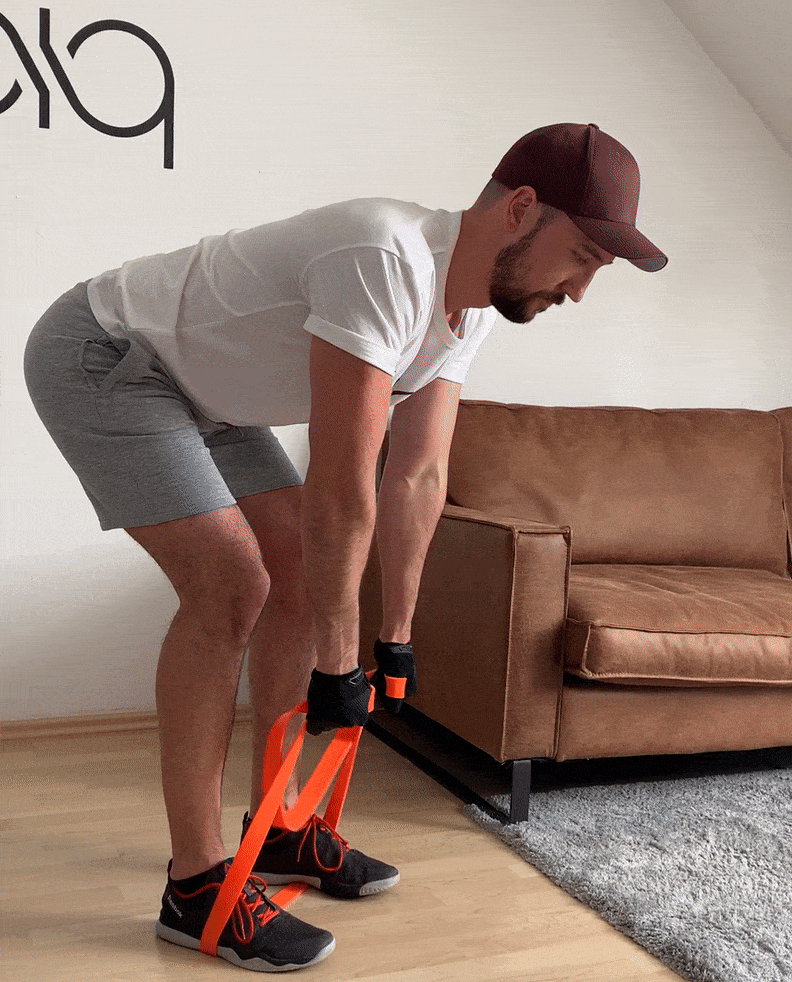
Now get your back straight and push your shoulder blades together and don’t turn your shoulders forward. Now you take the resistance band with each hand and move them towards you, focus on your elbows and not your hands to use your lat muscle and not your bicep to do this movement. Get behind your back with your elbows as much as you can, hold the contracting for a little bit and then slowly return your hands down.
Important Do’s & Don’ts!!!
 ⓵ Straight Back – do not form any kind of curve with your back. Many people do either bend their back or over-stretch it too much. Both will put a lot of stress on your lower back and you need to avoid that! Best practice is to stand next to a mirror and watch yourself from the side and you will clearly see how the optimal position feels for you.
⓵ Straight Back – do not form any kind of curve with your back. Many people do either bend their back or over-stretch it too much. Both will put a lot of stress on your lower back and you need to avoid that! Best practice is to stand next to a mirror and watch yourself from the side and you will clearly see how the optimal position feels for you.
⓶ Don’t internally rotate shoulder – a very common mistake is internal shoulder rotation when your shoulders will point forwards.
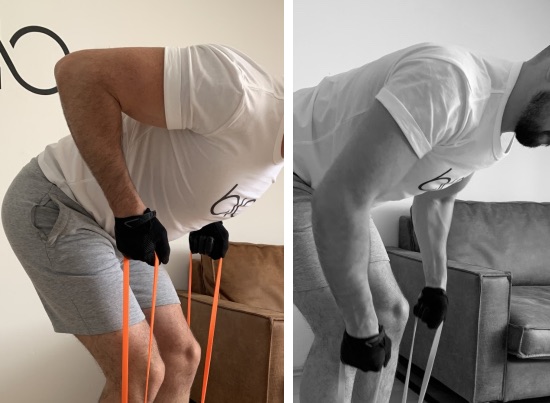
This position will not get you into a full contraction and make the standing row a lot less effective plus put extra stress on your rotator cuff and might lead to injuries long-term. Especially if you do this with lighter weight you run into this issue because you don’t feel the contraction that hard.
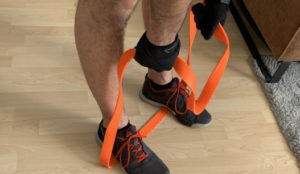 ⓷ No Slack – here comes the mistake that many do. The band needs to be pre-stretched a lot as the bent over row doesn’t let you adjust the resistance as freely as the standing row (more on that below).
⓷ No Slack – here comes the mistake that many do. The band needs to be pre-stretched a lot as the bent over row doesn’t let you adjust the resistance as freely as the standing row (more on that below).
If you can’t move your hands back without having slack in the initial position, you are very likely either grabbing the band with too much stretching or you use a band that’s too tough.

We have the best workout plan for resistance band training out there - and you can get it for free!Answer the 4 questions below and we send it to you, no strings attached!
Alternative Ways To Bent Over Row With Resistance Bands
With every version of an exercise, you will find people that really like it and others that don’t like it that much. If you have problems with the traditional way of doing the bent over row as shown above (while executing it the right way), you might want to try one of the alternative ways.
Grip Position – there are basically 3 different grip variations then it comes to rows – neutral, overhand and underhand.
The difference is quite small but it is still good to know what each grip is for.
- Neutral Grip – This is your most stable position. With this grip you should be able to handle the most resistance. Most of the work will be performed by your back and your biceps is slightly helping. You can also use this grip for the flared elbow version.
- Underhand Grip – This will involve your biceps the most. Perfect if you want to sneak a bit of biceps work in your back workout. Or simply to pre-exhaust your biceps in your back portion of your workout before hitting biceps directly. It is not suitable to be used with the flared elbow version.
- Overhand Grip – This grip is perfect for the flared elbow row variation. But you can also use this grip for the lat variation of the row. This will have the least biceps involvement and you will do most of the work with your back.
More Resistance
If you have the feeling that the standard version doesn’t give you enough resistance to work against, here are some ways that will help you get the perfect resistance to work your back right with the bent over rows.
Double Band – simply double up the band and you will get a full new set of resistances you can work with. With this variation you will also have a more stable grip, since you will grab the band inside the loop. Gibe it a try. But remember: you’re doubling up the band. Doubling bands also means that you double the resistance of the band. So you need to grab a lighter band for this variation.
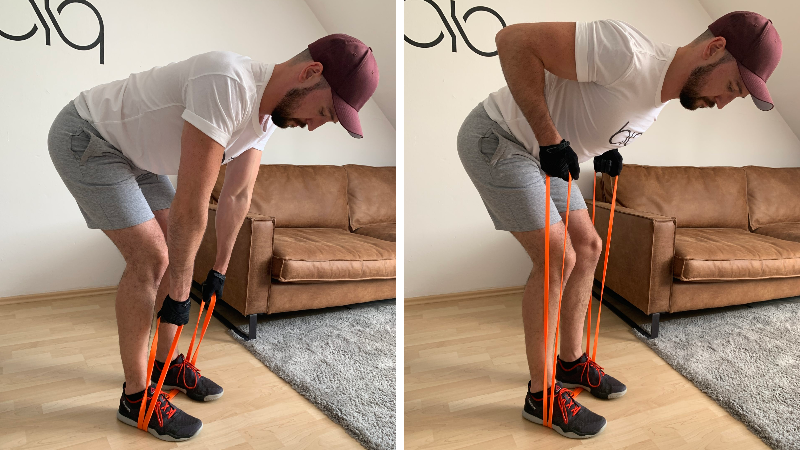
Loop-Grip – By grabbing the band like that you will have the option to adjust the resistance seamlessly and you also have a more stable grip on the resistance band. For that reason I always recommend using a loop style band over the tube bands with handles as they let you only adjust with your foot position (and for the bent over row you need them for stabilization, you can’t move them around as much as you want to. The wider your stance the less stability and control you have).
Also, this kind of grip works better, at least that’s my opinion.

Uni-Lateral Bent Over Row – a variation that will give you a larger range-of-motion with upright rows is switching it to uni-lateral and working each side individually. You might have heard of this as the lawn mower and I also like that you can get a little better direction for the band by stepping on the opposite side with your foot.
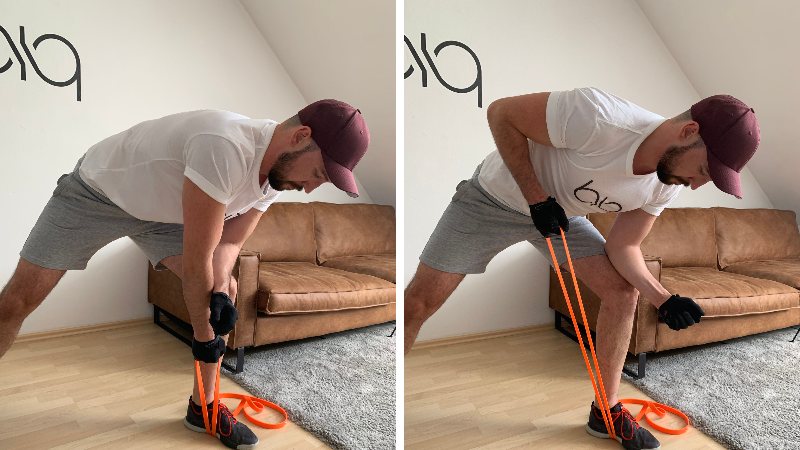
Full Back Workout
Simply doing bent over rows is not a full back workout as there are multiple muscles working in your back – we have here a full back workout with different exercises that will give you the strongest pump you can ever think of – check it out here.




